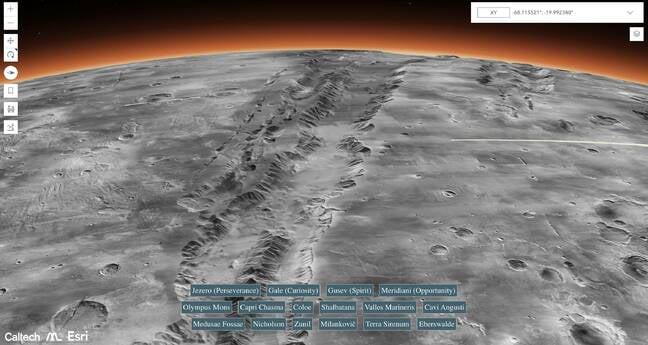This article is more than 1 year old
Move over, Google Earth. Caltech's here with a fresh 3D tour of Mars
Alien dust world globe took three years of hand-stitching images to create
Fancy a Mars flyover? You're in luck, as a team at Caltech just published a 5.7 terapixel mosaic of Mars that can be explored in 3D.
And, yes, things like Google Earth have models of Mars, but this one's better, or so we're told.
With a resolution of five metres per pixel, the new Global CTX Mosaic of Mars boasts twenty times the image quality of previous global Mars maps, Caltech said. It covers around 99.5 percent of the Martian surface, between 88 degrees North and 88 degrees South, with the remaining half percent missing because the Mars Reconnaissance Orbiter (MRO) either hasn't snapped shots of an area or the images weren't high enough quality to include.
The 110,000 images used to generate the map were snapped by the Context Camera onboard the MRO, which has been orbiting the Red Planet since 2006. Most of the mosaic was stitched together using a feature-matching algorithm that uses nondestructive processing to join images without resulting blurring or smoothing between image boundaries.
The algorithm wasn't able to do the entire thing on its own, though: Dickson and his team spent three years stitching 13,000 of the images together by hand because of clouds and dust storms in the images that meant the algorithm couldn't properly match them up without human help.
"The scale of this is really unprecedented," said Jay Dickson, lab manager at Caltech's Bruce Murray Laboratory for Planetary Visualization. Dickson was the architect of the new map and kicked the project off in 2016 when Caltech tapped him to establish the Lab he now heads.
And unprecedented scale it has: if printed out at 300 dpi, Caltech said, the whole 5.7 trillion pixel image would be large enough to use as a sunshade for California's Rose Bowl Stadium, and part of the parking lot as well. Sadly, Rose Bowl Stadiums aren't included in our standards converter.
Which Martian vista would you like to visit today?
The 3D map scales to "outcrop resolution," meaning it's detailed enough to make out small rock formations that could be of interest to scientists, but also is to the average internet user to view the contours of Mars.
"Schoolchildren can use this now. My mother who just turned 78 can use this now. The goal is to lower the barriers for people who are interested in exploring Mars," Dickson said.
Several interesting Martian geographical features are tagged with shortcuts on the bottom of the map, allowing users to quickly visit Olympus Mons, the dust-harboring Medusae Fossae or potential future landing site Terra Sirenum, among others.
For those who enjoy watching NASA's fleet of Mars rovers, Perseverance, Spirit, Opportunity, and Curiosity are all highlighted as well, with their daily routes traced out on the map so you can see just how far they are from each other, and how little of Mars' surface they've actually explored yet.
Armchair Mars explorers will have to make do with one restriction, though: All the images are in black and white, so the red part of the Red Planet will have to be filled in by your imagination.
Dickson admits the map is an impressive feat, but he gives credit to the Mars Reconnaissance Orbiter and its Context Camera for doing the real work.
"I worked on this for six years, but the MRO team has spent the past couple decades making this possible in the first place. And the spacecraft is still out there doing great science," Dickson said. ®

